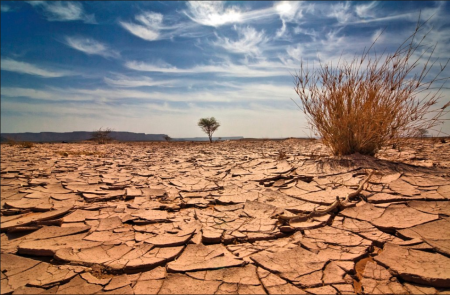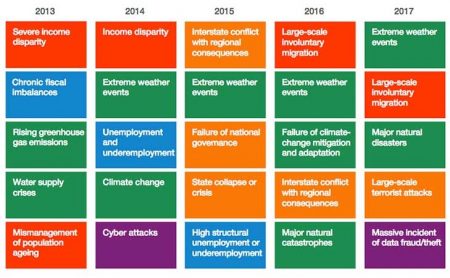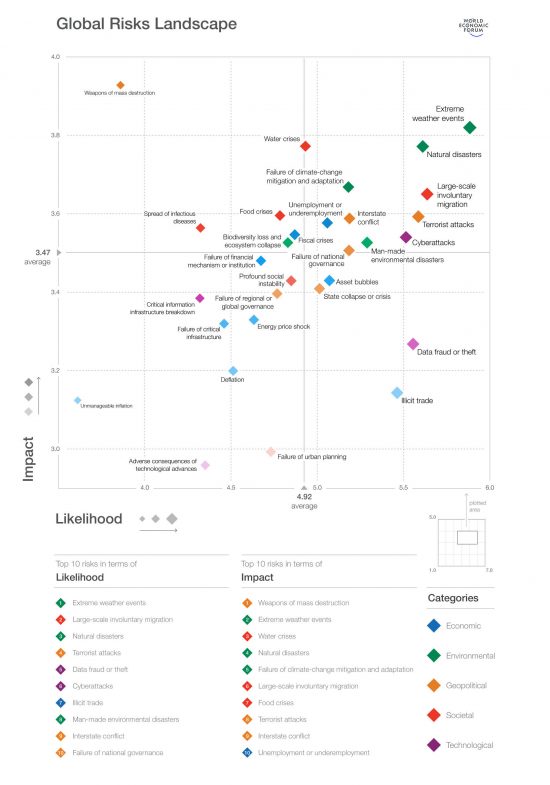January 19, 2017 – The World Economic Forum (WEF) publishes an annual risks report citing those factors posing the greatest challenge to the global economy. In its 12th edition, the report cites the environment as the number one risk to humanity. Past reports have not drawn such conclusions. For example in 2013 (see chart below) the number one risk was seen as severe economic disparity. Income disparity topped the 2014 report. In 2015 it was interstate conflict. And 2016 pointed to large-scale involuntary migration. But here in 2017 the environment gets top billing with extreme weather events and natural disasters positioned first and third.
The 12th edition of the report issued last week has put the environment at number one “even though the risk will play out over the long term.” That is evident as more and more “green” issues predominate. That the WEF describes the environment as a long-term high risk reflects what science has reported in this 21st century. Not just scientists provide evidence. The largest re-insurers, the companies that underwrite the insurance industry, report record payouts to cover rising extreme weather events. In the United States along the Atlantic seaboard, property owners are seeing the consequences with rising premiums for flood damage. And just this week NOAA and NASA issued their report showing 2014 through 2016 to be the warmest years since modern record keeping on global climate started back in 1880.
The WEF report states that “failure of mitigation and adaptation to climate change” will be the most prominent global risk, and that climate change will be “one of the top three trends to shape global developments over the next 10 years.” They describe the environmental risk as existential, a word we hear a lot these days.
What does existential mean?
Existential originally referred to a philosophy known as existentialism. Those who expounded existentialism were concerned with the nature of the human condition. They came up with their ideas during the late 19th and early 20th century. Existentialists saw the two world wars of the 20th century as the greatest threat to the way of life proposed by the philosophy. The greatest proponents were Kierkegaard, Nietzsche, Heidegger, Sartre and Camus. But existential has taken on a new meaning in the 21st century. Usually associated with the word threat, such as “the environment poses an existential threat to humanity,” its new means is about existence itself, about our survival as a species, and about the survival of the planet as we know it.
The WEF states that climate change ranks higher in terms of threat than “nuclear weapons or pandemic diseases.” The report talks about the emerging need to manage the “global commons,” another term that has become, of late, a new way of expressing a view of the Earth.
What is the global commons?
As I have written in the past here at 21st Century Tech blog, there are no political boundaries visible from space. Earth from space is a totality with land, ocean and atmosphere shared among all who inhabit the planet. These three elements are the global commons. When a nation or industry pollutes the air, when urban wastewater, garbage and farm runoff reaches rivers, lakes and oceans, we impact what we hold in common.
In the infographic displayed below, which appears in the WEF report, environmental categories pose the greatest risk. They appear as green diamonds. Those in red are indirectly related to environmental risk. For example, involuntary migration, water crises, food crises and spread of infectious diseases.
What does involuntary migration have to do with climate change and extreme weather events?
In articles appearing in 2015 in both Time Magazine and Scientific American, the authors described the Syrian civil war as a consequence of climate change. Drought and bad government policies forced more than one million Syrian farm families to abandon their traditional livelihood. They crowded into Syria’s cities. They put stress on already bad urban conditions and corrupt politics. Water shortages, devastated farms, and pervasive corruption sowed the seeds of Syria’s version of the Arab Spring. And Syria didn’t stand alone. Drought and other climate change phenomena impacted much of North and Sub-Saharan Africa.
That’s why the American Pentagon has described climate change as a “threat multiplier.” The WEF Report concurs with this military assessment.


















